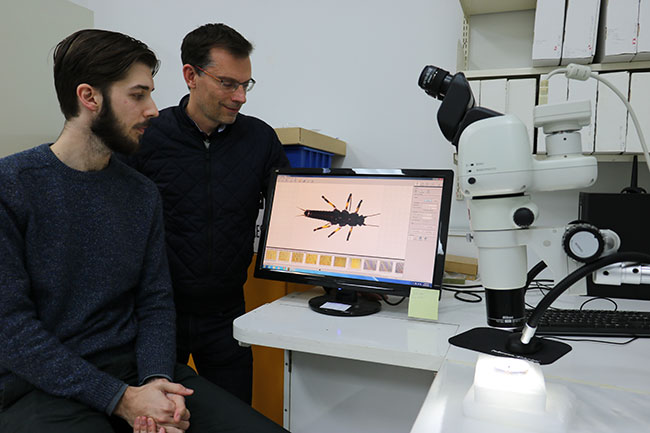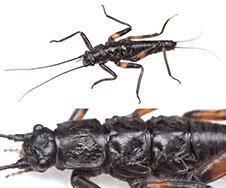Friday 7 June 2019 9:50am

Brodie Foster (L) and Prof Jon Waters (R) examining the Maungatua stonefly
A team of zoologists from the University Otago has discovered a new species of insect – the Maungatua stonefly – from the slopes of the Maungatua Range, on the doorstep of Dunedin.
The unique stonefly, just under 2cm in length, has so far been found living in only a few hundred metres of subalpine stream habitat, just below the summit of Maungatua, overlooking Dunedin Airport.
The team used DNA evidence to show that the species has likely been isolated in the region for around 2 million years.
“It’s remarkable to find such a distinctive, relict species so close to home”, says Zoology PhD student Brodie Foster, an entomologist who led the description of the new species.

Photo credit: Brodie Foster.
Stoneflies have life cycles similar to those of mayflies, where nymphs spend their early lives under stones in the rapids of fast-flowing streams. As their name implies, most stoneflies can fly, developing large wings once they emerge from streams as adults.
However, the newly discovered Maungatua stonefly is unusual in that it has apparently adapted to the windy conditions on Maungatua by losing its ability to fly – its wings being reduced to tiny remnants. Being unable to fly also helps to explain why this new species has such a small geographic range.
“It’s exciting that there are still these new discoveries to be made about New Zealand’s native animals” says study supervisor Professor Jon Waters, who found and collected the new stonefly species – almost by accident.
Professor Waters was searching for another more widespread species of stonefly - in some very rough terrain on the Maungatuas - when he stumbled across the new species.
“We knew the discovery was something unusual straight away, but it took a bit of detective work, using DNA, to work out that it was something completely new”, Professor Waters says.
While the new discovery is exciting for science, the narrow distribution of the new species might be the cause of conservation concern.
“As far as we know, this unique insect is restricted to a tiny amount of subalpine habitat on the slopes of Maungatua. It’s really important that we learn more about it, and make sure that its few populations remain secure,” Mr Foster says.
The new discovery is published in the New Zealand Journal of Zoology.
The type material of the new species has been deposited in Otago Museum.
For more information, please contact:
Brodie Foster
Department of Zoology
University of Otago
Email brodie.foster@otago.ac.nz
Professor Jon Waters
Department of Zoology
University of Otago
Email jon.waters@otago.ac.nz
